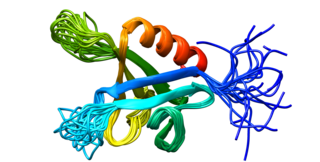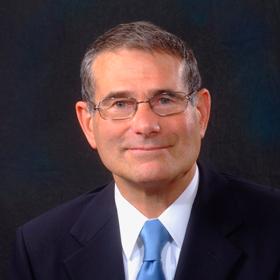
Gelsolin is an actin-binding protein that is a key regulator of actin filament assembly and disassembly. Gelsolin is one of the most potent members of the actin-severing gelsolin/villin superfamily, as it severs with nearly 100% efficiency.

Cortactin is a monomeric protein located in the cytoplasm of cells that can be activated by external stimuli to promote polymerization and rearrangement of the actin cytoskeleton, especially the actin cortex around the cellular periphery. It is present in all cell types. When activated, it will recruit Arp2/3 complex proteins to existing actin microfilaments, facilitating and stabilizing nucleation sites for actin branching. Cortactin is important in promoting lamellipodia formation, invadopodia formation, cell migration, and endocytosis.

Keratin, type II cytoskeletal 8 also known as cytokeratin-8 (CK-8) or keratin-8 (K8) is a keratin protein that is encoded in humans by the KRT8 gene. It is often paired with keratin 18.

Ezrin also known as cytovillin or villin-2 is a protein that in humans is encoded by the EZR gene.

Protein tyrosine kinase 2 beta is an enzyme that in humans is encoded by the PTK2B gene.

Dynamin-2 is a protein that in humans is encoded by the DNM2 gene.

Alpha-actinin-1 is a protein that in humans is encoded by the ACTN1 gene.

Vasodilator-stimulated phosphoprotein is a protein that in humans is encoded by the VASP gene.

Alpha-actinin-4 is a protein that in humans is encoded by the ACTN4 gene.

Zyxin is a protein that in humans is encoded by the ZYX gene.

Macrophage-stimulating protein (MSP), also known as hepatocyte growth factor-like protein, is a protein that in humans is encoded by the MST1 gene.

F-actin-capping protein subunit alpha-1 is a protein that in humans is encoded by the CAPZA1 gene.

Protein flightless-1 homolog is a protein that in humans is encoded by the FLII gene.

Neurabin-2 is a protein that in humans is encoded by the PPP1R9B gene.

Cdc42 effector protein 1 is a protein that in humans is encoded by the CDC42EP1 gene.

Supervillin is a protein that in humans is encoded by the SVIL gene.

Tensin-1 is a protein that in humans is encoded by the TNS1 gene.

Tropomodulin 4 (muscle) also known as TMOD4 is a protein which in humans is encoded by the TMOD4 gene.

Thomas P. Stossel was an American hematologist, inventor, medical researcher, and writer that discovered gelsolin, and invented the BioAegis technology estate. He was also a professor emeritus of medicine at Harvard Medical School and professor emeritus of clinical research at the American Cancer Society. He was Chief Scientific Advisor to BioAegis Therapeutics Inc., a clinical stage biotech company developing a non-immunosuppressive, anti-inflammatory with potential to address a wide range of infectious, inflammatory and degenerative diseases. He is the holder of more than 50 patents and had authored more than 300 papers, studies, and reviews. He was also a member of the National Academy of Sciences, the American Academy of Arts and Sciences, and the National Academy of Medicine, past editor-in-chief of Current Opinion in Hematology and past editor of the Journal of Clinical Investigation, past president of the American Society of Hematology and the American Society for Clinical Investigation.

Villin 1 is a protein that in humans is encoded by the VIL1 gene.


























